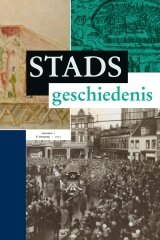Stadsgeschiedenis editie 2013 - 2

|
Tineke Van de Walle Brecht Dewilde Hans Blanken (Review) Maarten Walraven (Review) Jan Hein Furnée, Petra Brouwer en Manon van der Heijden (Interview) Inge Bertels & Stijn Oosterlynck |
Abstracts
Tineke Van de Walle, Op weg naar het centrum van de wereld. Een analyse van pelgrimsverhalen naar Jeruzalem en de perceptie van stedelijkheid (1480-1585)
In the late fifteenth and sixteenth century the Netherlands were a highly densely urbanized area. How did western city dwellers perceive ‘urbanity’? To answer this question this articles analyses western descriptions of Jerusalem and more especially the travel accounts of pilgrims as Joos van Ghistele, Georges Lengherand, Arent Willemszoon, Jacques Le Saige, Adriaen Van Nispen en Jean Zuallart. All these authors originated from the densely urbanized Low Countries. Their representations of an eastern, ‘strange’ city, but also the references to and comparisons with familiar western cities give us the opportunity to reveal their urban frame of reference. Which elements determine their experience of urbanity? Did all pilgrims observe and share them equally? And what does this tell us about their western urban frames of references? Since Jerusalem was an important component of the Christian worldview of the pilgrims we confronted their accounts with the descriptions of non-Christian authors: Mudjir al-Din al-‘Ulaymi, a chief justice from Jerusalem and the Turkish author Evliya Çelebi, originating from Istanbul. This will allow us to reflect on the author’s Christian prejudices. We compare the travel accounts before and after the conquest of Jerusalem in 1517, enabling us to verify the reliability of the western testimonies and can we trace the potential changes in the perception of Jerusalem. To which degree did the pilgrims detect the transformations of the city by Suleyman the Great? Are there fluctuations in the emphases the pilgrims put in their representations?
Brecht Dewilde, Theater en commerciële cultuur in een secundaire stad. Rederijkerskamer De Kersouwe te Leuven, zeventiende-achttiende eeuw
Starting from the pioneering studies of Borsay and Plumb, this article investigates the commercialization of theatre culture in the provincial town of Leuven, and the ability of the local chamber of rhetoric ‘De Kersouwe’ to cope with this changed cultural setting. It shows how a subgroup of ‘amateurs’, consisting of artists and intellectuals, remodelled De Kersouwe into a market oriented theatre production company. Under its management, De Kersouwe set up performances at a charge and introduced new genres and styles of playing. Hence, in line with Borsay and Plumb, this article argues that the emergence of a ‘modern’ theatre culture did not only occur in the larger, more progressive considered centres like Antwerp or Brussels, but also in secondary towns considered less innovative. As such this article includes a plea for a positive reassessment of provincial theatre in the Low Countries in the seventeenth and eighteenth century.
Hans Blanken, 'De Kei, der burgers grootste schat'. Alternatieve historische cultuur in twintigste-eeuws Amersfoort
This article analyses the Amersfoort ‘boulder’ tradition over the course of the twentieth century. After the 1903 excavation of this millennium-old boulder, which had played the central role in a curious seventeenth-century popular festival, it became the symbol of the city of Amersfoort. The various festivities in the twentieth century honouring this monument were organized bottom-up, contrary to most public memory events. These celebrations had an outspoken ludic nature in which the celebrants related to the past in a playful manner and the commemoration was continuously adjusted to fit contemporary needs. The twentieth century history of the Amersfoort boulder demonstrates that memory objects that initially were of marginal significance could play an important role in local urban culture.
Maarten Walraven, De luisterende historicus, akoestische gemeenschappen en de moderne stad
Historians have seriously attended to the sounds of history for around fifteen years now. This review article presents a state of the field with a specific focus on the modern city of the nineteenth and twentieth centuries. I discuss some of the key works and two major themes of audible history: noise and music. Furthermore, I ask what methodologies historians have used to get to sound and make suggestions on how to further develop the possibilities to reach and recompose the sounds of history. Key to that development is the idea of the acoustic community as well as the acoustic contexts of the places and spaces of history.